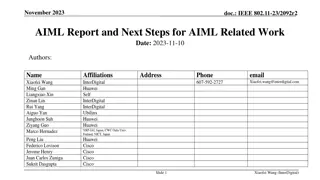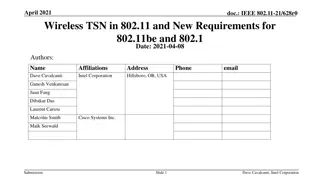IEEE 802.11-23/1874r0: Reverse TXOP Sharing for Improved Wireless Communication
This contribution presents the concept of Reverse TXOP Sharing in IEEE 802.11 networks, allowing non-AP STAs to share their TXOP with APs for efficient data transmission. The proposal addresses current limitations in TXOP utilization and offers a mechanism for enhanced Downlink and Uplink traffic management, aiming to optimize channel access and reduce collisions.
Download Presentation

Please find below an Image/Link to download the presentation.
The content on the website is provided AS IS for your information and personal use only. It may not be sold, licensed, or shared on other websites without obtaining consent from the author.If you encounter any issues during the download, it is possible that the publisher has removed the file from their server.
You are allowed to download the files provided on this website for personal or commercial use, subject to the condition that they are used lawfully. All files are the property of their respective owners.
The content on the website is provided AS IS for your information and personal use only. It may not be sold, licensed, or shared on other websites without obtaining consent from the author.
E N D
Presentation Transcript
doc.: IEEE 802.11-23/1874r0 November 2023 Reverse TXOP sharing Date: 2023-11-14 Authors: Name Affiliations Address Phone Email Sindhu Verma sindhu.verma@broadcom.com Shubhodeep Adhikari shubhodeep.adhikari@broadcom.com Matthew Fischer matthew.fischer@broadcom.com Broadcom Vinko Erceg vinko.erceg@broadcom.com Kamal Singhal kamal.singhal@broadcom.com Bijoy Bhukania bijoy.bhukania@broadcom.com Submission
doc.: IEEE 802.11-23/1874r0 Abstract This contribution discusses the benefits and mechanism for Reverse TXOP Sharing i.e. allowing a TXOP acquired by a non-AP STA to be shared with an AP and further, allowing the AP to utilize the shared TXOP for carrying appropriate Downlink and Uplink traffic Submission Slide 2
doc.: IEEE 802.11-23/1874r0 Problem Statement (1) During normal operation in 802.11, only an AP can share its TXOP with its clients in the following manner: 11ax onwards, using Triggered allocations for Uplink transmissions 11be onwards, using TXS Mode 1 for SU Uplink transmissions and TXS Mode 2 for P2P- like transmissions In certain scenarios, such sharing by the AP is beneficial in reducing channel access attempts and collisions at the clients to transmit UL data. In other scenarios where there is significant OBSS congestion, it is beneficial to keep the clients contending for channel access so that the BSS in question gets a commensurate share of the medium. However this entails the following problems: Each client can utilize its TXOP only for its own Uplink transmissions There is no mechanism to share the unutilized portion for Downlink data and Uplink data corresponding to other clients even if there is pending latency-sensitive/control traffic Submission Slide 3
doc.: IEEE 802.11-23/1874r0 Problem Statement (2) There can also be cases where the AP is unable to win channel access or when it wins access, it is not aligned with the availability of idle medium at the client i.e. there may be hidden node issues at the client which would make it more optimal for the client to be the initiator of TXOPs For these reasons, it is beneficial to have a scheme that allows a TXOP acquired by a non-AP STA to be shared with an AP and further, allows the AP to utilize the shared TXOP for carrying appropriate Downlink and Uplink traffic The Reverse Direction (RD) protocol allows TXOP sharing between an RD Initiator and Responder, where the Initiator can be a non-AP STA. However, the protocol allows only a limited version of such TXOP sharing. For example, the RD Responder (say an AP) can transmit data only to the RD Initiator (say a non-AP STA) and inclusion of traffic to other STAs can only be done in an MU fashion and without extending the duration beyond that required for the transmission to the RD Initiator (Section 10.29.4). Submission Slide 4
doc.: IEEE 802.11-23/1874r0 Proposed Solution In UHR, a non-AP STA can be required to share its TXOP with the AP optionally after utilizing it for its own transmission or mandatorily The full duration or remainder of this TXOP can be shared with the AP The indication to the AP will consist of the remaining duration as well as the AC with which the TXOP was acquired In this TXOP acquired and shared by a non-AP STA, the AP can prioritize low latency control/data to any non-AP STAs. It can also schedule corresponding UL transmissions from non-AP STAs. It can also transmit or schedule other data depending on the AC with which the TXOP was acquired SIFS gap is mandated between consecutive transmissions with the option of PIFS-based recovery Submission Slide 5
doc.: IEEE 802.11-23/1874r0 Regulating the Proposed Solution It is the non-APs decision whether to share its TXOP especially if it has pending data to transmit The non-AP indicates that it has completed transmitting, the access category of gaining the TXOP, and the remaining duration in the TXOP. How to utilize the remainder can be as follows: Only for transmissions to the particular non-AP which shared the TXOP Additionally for latency-sensitive and control traffic to other non-APs as well Additionally for any traffic with priority equal to or higher than the indicated AC but up to a threshold duration. It can be considered whether such TXOPs can be shared between STAs in different BSSs via multi-AP coordination. Submission Slide 6
doc.: IEEE 802.11-23/1874r0 Benefits of the Proposed Solution The proposed solution allows the non-AP STAs to contend for channel access and share the resources with the AP for better QoS management across the BSS: The AP can prioritize latency-sensitive and control traffic The AP can manage fairness between Downlink and Uplink traffic as well as among multiple non-AP STAs It also allows efficient utilization of TXOPs and less idle time in the medium (due to channel access gaps between shorter transmissions from individual non-APs) It allows the BSS to continue to have a commensurate share of the medium while having the advantages of scheduled access It allows management of hidden node situations where the non-AP may have better visibility of the Downlink interference situation and hence, can poll for Downlink transmissions Submission Slide 7
doc.: IEEE 802.11-23/1874r0 Discussion on possible drawbacks (1) What is the incentive for a non-AP to share its TXOP? The non-AP shares only the remaining TXOP that it otherwise cannot use. This reduces the number of EDCA accesses for a given amount of Tx/Rx on the channel and so improves efficiency. For example, this same non-AP can be a beneficiary for this scheme where its DL/UL traffic are carried in a TXOP initiated by another non-AP APs will use MU-EDCA and triggered allocations. Why will the non-APs gain TXOPs? For TXOPs won by the AP, the benefit due to packing multiple UL/DL flows in the same TXOP already occurs. This proposal is for the case when the TXOPs are won by the non-APs. It is intended to optimize channel usage (in terms of total Tx/Rx time, packing multiple UL/DL flows) for this case. Submission Slide 8
doc.: IEEE 802.11-23/1874r0 Discussion on possible drawbacks (2) Will the TXOPs become longer and so latencies of latency-sensitive traffic degrade? The TXOPs become longer due to inclusion of possibly latency-sensitive traffic within the same TXOP rather than separated by TXOPs of other users (both inBSS and OBSS) and EDCA backoffs. TXOP sharing would lead to better packing efficiency and lower wait/idle times. If dedicated for the purpose of benefiting latency-sensitive traffic, can t anyone easily mark any traffic as latency-sensitive and misuse this feature? That can occur even without this feature. If this is the norm, use of various access categories for EDCA and rTWT are also questionable. Even then, the usage is limited to the duration of the max TXOP. Submission Slide 9
doc.: IEEE 802.11-23/1874r0 Conclusion Reverse TXOP sharing has the following advantages Efficient resource utilization Low latency and control traffic prioritization QoS management Mitigation of hidden node issues The 802.11 specification changes required in UHR are minimal. They can simply be an extension of the 11be TXS modes 1 and 2. Submission Slide 10
doc.: IEEE 802.11-23/1874r0 References [1] IEEE P802.11be [2] 11-20-0005-01-00be-Proposals on Latency Reduction /D5.0 Submission Slide 11























